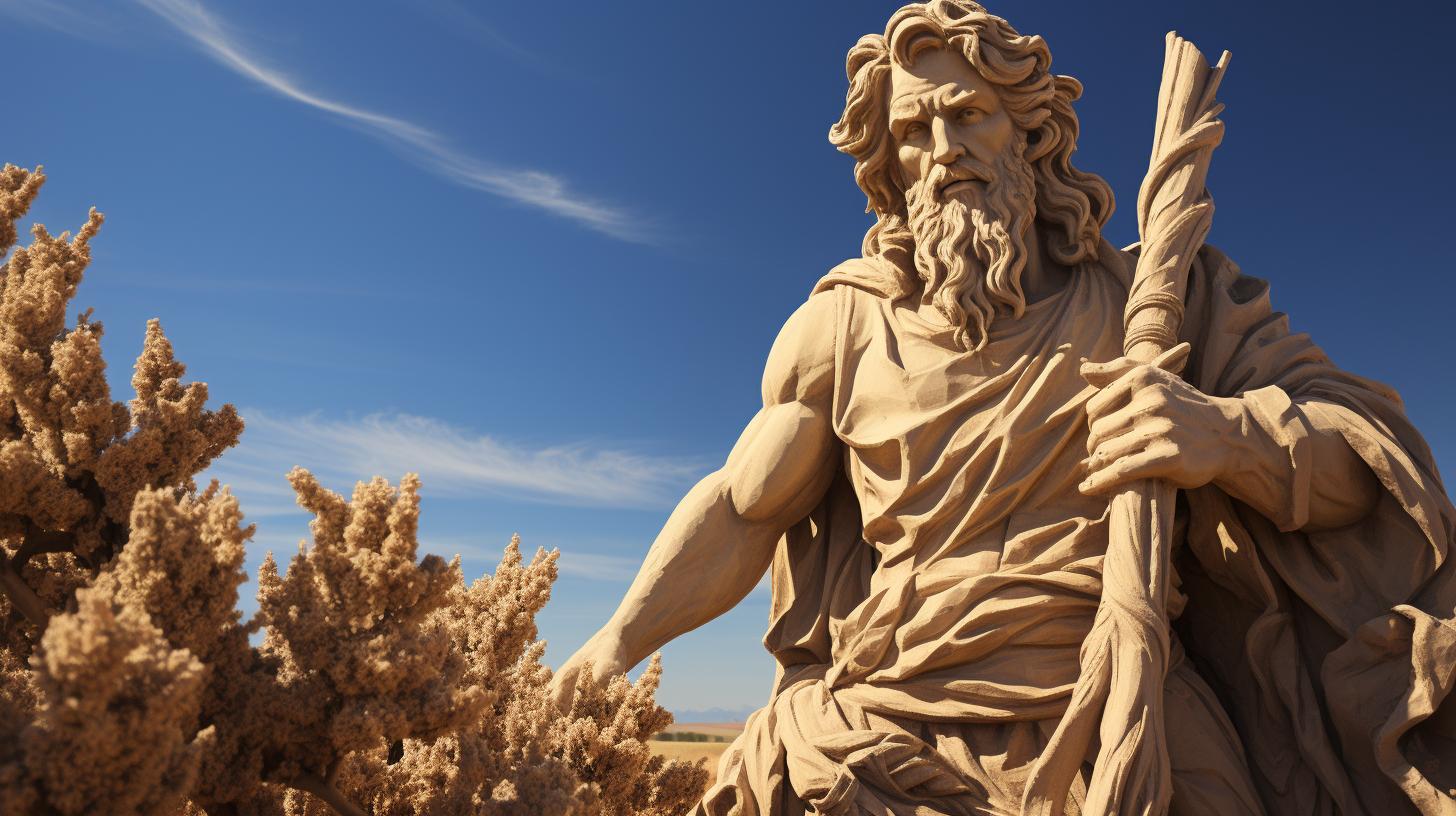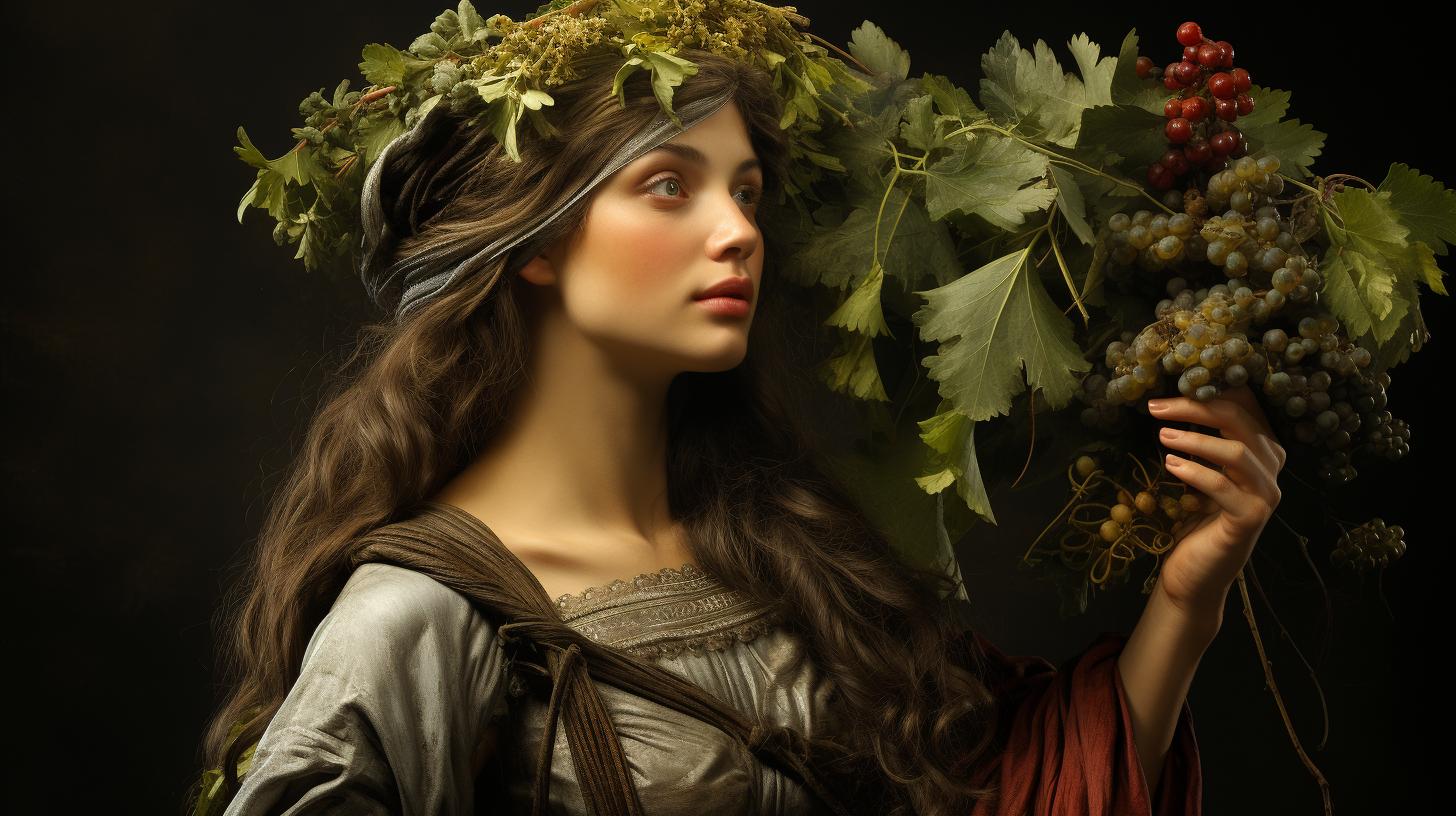Roman Goddess Terra: Unveiling the Power and Significance of the Earth Personification in Roman Mythology

Roman goddess Terra Mater, the personification of the Earth in Roman mythology, holds a significant place in the pantheon of Roman deities. As the Roman goddess of earth and fertility, Terra Mater is often compared with the Greek goddess Gaia, also known as Terra in Greek mythology.
This article delves into the origins and symbolism of Terra Mater, explores her role as a mother goddess, and examines her connection to Roman agricultural festivals. Additionally, we explore the mysteries surrounding the Temple of Terra Mater and its enigmatic object, the magmentarium, often thought to be a sacred symbol of this earth goddess.
Join us on a journey to uncover the power and legacy of this revered Roman earth goddess. Stay tuned for a captivating exploration of Terra Mater, a key figure in both Roman and Greek mythology, and her influence in Roman culture and beyond.
Overview of Roman Mythology
Roman mythology is a captivating tapestry of legends, beliefs, and narratives that shaped the cultural and religious fabric of ancient Rome. This rich mythological tradition played a fundamental role in Roman society, influencing various aspects of Roman life including politics, art, literature, and religious practices.
Introduction to Roman Mythology
At the core of Roman mythology lies a diverse pantheon of gods, goddesses, heroes, and mythical creatures. These mythological tales served to explain the natural phenomena, establish genealogies, and provide moral guidance to the Roman people.
Key Figures in Roman Mythology
Among the prominent figures in Roman mythology are Jupiter, the king of gods; Juno, the queen of gods and protector of matrimony; Mars, the god of war; and Venus, the goddess of love and beauty, reflecting the rich tapestry of divine influence that permeates Roman lore.
These deities, along with a multitude of others, played significant roles in the Roman mythological narratives, each contributing to the overarching themes of power, fertility, and the natural world, epitomized by Terra Mater, the Roman goddess of the earth.
Role of Goddesses in Roman Mythology
The goddesses in Roman mythology held diverse roles and responsibilities. They represented different aspects of life, including love, wisdom, fertility, and nature. These powerful female figures were revered and worshipped, often having a profound influence on various domains of Roman society.
As the Roman earth goddess, she was central to the spiritual life in ancient Rome, embodying the earth’s power and its vital role in Roman religious practices.
Overall, an exploration of Roman mythology provides us with a deeper understanding of the ancient Roman mindset, their worldview, and the profound impact of mythological beliefs on their lives, particularly through figures like Terra Mater, the Roman goddess of earth and nature.
Exploring Roman Goddess Terra Mater
Discover the fascinating origins and rich associations surrounding the revered Roman goddess Terra Mater. Her significance in Roman mythology goes beyond mere earth personification, reaching deep into the cultural fabric of ancient Rome.
She is often equated with the Greek goddess Gaia, sharing similarities and differences that illuminate her unique role as a deity of the earth.
Origins and Associations of Terra Mater
Delve into the mythological origins of Terra Mater and unravel the complex web of associations surrounding her. Explore the evolving interpretations of her name, Terra, and its potential connection with the goddess Tellus, and uncover the intriguing debates surrounding these two deities.
This exploration reveals her layers as both a terra roman goddess and a symbol of the earth in ancient Rome.
Comparison with Greek Goddess Gaia
Understanding Terra Mater also involves comparing her to Gaia, the Greek earth goddess. Both are powerful symbols in their respective mythologies, representing the Earth and its attributes. While Gaia is central to Greek mythology, Terra Mater holds a parallel position in Roman tales, highlighting their shared heritage and distinct mythological evolution as earth goddesses.
Explore the parallels between Terra Mater and the Greek goddess Gaia, the embodiment of the Earth in Greek mythology. Examine their shared attributes and symbols, and delve into the cultural influences and exchanges that occurred between the Roman and Greek pantheons, often symbolized by Terra as the Roman god of the earth and Gaia as the Greek counterpart.
Symbolism and Representation of Terra Mater
Unlock the symbolic richness of Terra Mater and the various ways she was represented in Roman imagery and art. From flowers and fruits to livestock and the cornucopia, each symbol carries profound meaning, reflecting her association with fertility, abundance, and agricultural prosperity.
These icons not only depict her as a nurturing mother but also underline her role as the terra roman goddess, central to Roman culture and spirituality.
Terra Mater’s Role as a Mother Goddess
As the terra goddess and a pivotal figure in Roman mythology, Terra Mater’s role transcends the mere personification of the earth, embodying the nurturing aspects of nature and motherhood.
Her divine duties intertwine with her identity as the goddess of earth, impacting everyday life and spiritual practices in ancient Rome.
Terra Mater and Roman Agricultural Festivals
As the goddess of the Roman land, her veneration was considered essential for the success of agricultural endeavors and the prosperity of the community.
Rituals and Celebrations Dedicated to Terra Mater
The worship of Terra Mater, the Roman goddess of nature, was marked by various rituals and festive gatherings that centered around agricultural prosperity.
Throughout the year, Romans would partake in ceremonies to honor and seek the blessings of Terra Mater, invoking her as the god of earth and fertility during key agricultural festivals.
These rituals often involved offerings of fruits, flowers, and livestock to symbolize fertility and abundance.
The aim was to appease the goddess and ensure a bountiful harvest for their agrarian society.
Connection Between Terra Mater and Ceres
Terra Mater’s association with agriculture was closely intertwined with that of another prominent goddess, Ceres. Both goddesses were revered as the embodiments of fertility and sustenance. Many festivals dedicated to Terra Mater were celebrated in conjunction with Ceres, emphasizing the interconnectedness of the earth and the harvest.
The joint worship of Terra Mater and Ceres highlighted the communal efforts to promote agricultural prosperity and maintain the well-being of society.
Importance of Agricultural Practices in Roman Society
Agricultural practices held immense significance in Roman society, as they were the backbone of their economy and social structure. With an agrarian lifestyle encompassing most of the population, the success of crops directly impacted the prosperity and stability of the community.
The worship of Terra Mater and the rituals associated with agricultural festivals provided a spiritual connection to the land, reinforcing the importance of sustainable farming practices and the harmonious relationship between humans and nature.
The Temple of Terra Mater and Its Mysteries
The Temple of Terra Mater holds a significant place in Roman culture and mythology. Built in the aftermath of a devastating earthquake, this sacred sanctuary became a focal point of worship and intrigue.
Let us delve into the historical background, architectural marvel, enigmatic magmentarium, and overall importance of this revered temple in Roman society.
Historic Background of the Temple
The Temple of Terra Mater, often referred to as Tellus Mater, was constructed in the wake of an earthquake that struck ancient Rome. The calamity was interpreted as a divine message, necessitating the commemoration of Terra Mater, the personification of the Earth and the Roman goddess of the earth.
It stood as a testament to the Romans’ belief in the power and significance of the natural world, symbolizing their reverence for Terra, the Roman god of the earth.
Architecture and Design of the Temple
The architectural design of the Temple of Terra Mater showcased exquisite craftsmanship and attention to detail.
Its grandeur was marked by towering columns and intricate carvings, reflecting the Roman aesthetic sensibilities and the spiritual significance of Terra Mater, the goddess of the Roman land.
The interior spaces exhibited a seamless fusion of religious symbolism and artistic expressions, immersing worshippers in a sublime atmosphere of devotion.
The temple’s layout and ornaments were rich in symbols of Terra, emphasizing her role as a central figure in terra Roman mythology.
Unraveling the Mystery of Magmentarium
Within the Temple of Terra Mater resided an enigmatic object known as the magmentarium. The true nature and purpose of this mysterious artifact remain shrouded in uncertainty, captivating the imagination of scholars and historians for centuries.
Some believe it to be a sacred relic, while others theorize its role in fertility rituals associated with Terra Mater. This ambiguity adds to the mythology of Terra, enhancing her mystique as both a terra mater goddess and an integral part of the cultural and religious fabric of ancient Rome.
Significance of the Temple in Roman Culture
The Temple of Terra Mater held immense cultural and religious significance in ancient Rome. It served as a gathering place for worshippers to pay homage to the goddess of fertility and abundance.
The rituals and ceremonies conducted within its sacred walls reinforced the Roman society’s deep-rooted connection with the Earth and emphasized the importance of agricultural practices in ensuring prosperity. These gatherings were essential rituals to honor the Roman god of earth, emphasizing her role as a key figure in ensuring the land’s fertility.
Visiting the Temple of Terra Mater was not just an act of religious devotion but also a symbol of reverence for the foundational forces governing life itself. This revered sanctuary stands as a testament to the Romans’ veneration of Terra Mater, their recognition of the Earth’s inherent power and nurturing qualities, and their deep respect for the goddess of earth Roman.
Terra Mater in Art and Literature
The depiction of Terra Mater in visual arts captures the essence of her role as the personification of Earth in Roman mythology. Artists sought to portray her as a nurturing and abundant figure, emphasizing her association with fertility and sustenance.
Paintings and sculptures often showcased Terra Mater adorned with flowers, fruits, and a cornucopia, symbolizing her role in promoting growth and prosperity. These artistic representations not only celebrated her divine nature but also served as a reminder of the importance of the Earth in Roman society.
Depictions of Terra Mater in Visual Arts
- Paintings: Many renowned Roman artists, such as Titian and Rubens, created beautiful artworks depicting Terra Mater. These paintings often featured vivid landscapes, with Terra Mater at the center, radiating a sense of power and fecundity.
- She was often shown surrounded by bountiful harvests, flowing rivers, and fertile fields, invoking a connection between nature and the goddess herself.
Such depictions emphasized her role as the terra goddess of the earth, a central figure in terra mythology, and a symbol of nature’s bounty.
- Sculptures: Sculptors carved statues of Terra Mater from various materials, such as marble and bronze, which often depicted her with symbols like the cornucopia, signifying her role as a provider of prosperity and fertility in Roman beliefs.
These statues showcased her maternal and nurturing attributes, portraying her with open arms and a serene expression.
The sculptures not only represented Terra Mater as a divine figure but also served as a reminder of the Earth’s abundance and the need for its preservation.
Terra Mater in Roman Literature and Poetry
Roman literature and poetry played a significant role in preserving the legacy of Terra Mater.
Writers, such as Ovid and Virgil, often mentioned her in their works, emphasizing her connection to nature and her role as the mother of all gods. Terra Mater was often associated with the concept of “genetrix,” an embodiment of generative powers that gave life to all living beings.
- Ovid’s Metamorphoses: Ovid’s epic poem, Metamorphoses, includes references to Terra Mater and her role in the creation of the world. He describes her as the provider of fertility and abundance, nurturing all living creatures with her divine grace.
- Through his poetic verses, Ovid immortalizes Terra Mater’s importance in the Roman mythological landscape, often invoking her as the god of earth roman, which in Greek translates to her being known as a provider of life and sustenance.
- Virgil’s Georgics: In his renowned work, Georgics, Virgil connects the agricultural practices of ancient Rome with the reverence for Terra Mater.
- He highlights the vital role of the Earth in ensuring the prosperity of the Roman people and emphasizes the intimate relationship between human beings and the natural world.
Virgil’s poetic tribute celebrates the goddess and elevates her status as a symbol of prosperity and fertility, further enriching our understanding of Terra as the roman god of land.
Influence of Terra Mater on Roman Symbolism and Iconography
The influence of Terra Mater extended beyond art and literature, permeating Roman symbolism and iconography.
Her association with fertility and abundance led to her incorporation into various aspects of Roman culture.
- Architectural designs: Terra Mater’s imagery was often incorporated into architectural designs, including the decoration of temples and public buildings.
Her symbols, such as the cornucopia and agricultural implements, adorned these structures, signifying the importance of the Earth and its connection to the divine.
- Amulets and jewelry: People wore amulets and jewelry depicting Terra Mater as a way to invoke her blessings and protection.
- These ornaments often featured her symbols, such as flowers, fruits, and images of agricultural abundance.
Carrying or wearing these talismans was believed to bring good fortune and prosperity.
The influence of Terra Mater on Roman symbolism and iconography not only reinforced her role as a motherly figure but also served as a constant reminder of the Earth’s essential role in sustaining life.
Terra Mater in Relation to Other Roman Deities
Terra Mater, the Roman goddess representing the Earth, had significant interactions with various other gods and goddesses in Roman mythology. These connections shed light on her role and prominence within the divine pantheon.
Interaction with Other Roman Gods and Goddesses
- Jupiter (Zeus): As the king of the gods, Jupiter held immense power and authority. Terra Mater was often considered the mother of Jupiter and played a crucial role in his lineage and divine ancestry.
- Neptune (Poseidon): As the god of the sea and earthquakes, Neptune had a connection with Terra Mater through the elemental forces they both represented.
Their interactions emphasized the intertwined nature of land and water.
- Mars (Ares): Terra Mater’s influence extended to the god of war, Mars. It is believed that Terra Mater bestowed her blessings upon Mars, symbolizing the connection between fertility, agriculture, and the protection of the land during conflicts.
Terra Mater’s Connection to Fertility and Abundance
Terra Mater’s association with fertility and abundance was closely linked to her interactions with other deities.
Here are some key connections:
- Ceres (Demeter): Terra Mater and Ceres shared a deep connection as goddesses of fertility and agriculture. They worked in tandem to ensure the bountiful harvests and the well-being of crops, emphasizing their essential roles in Roman agricultural practices.
- Bacchus (Dionysus): Terra Mater had a connection with Bacchus, the god of wine and ecstasy.
As wine and grape cultivation relied on fertile land, Terra Mater’s influence was crucial to the abundance of grapes and the success of viticulture.
- Flora: Terra Mater’s association with Flora, the goddess of flowers and spring, highlighted the interconnectedness of nature and the cyclical patterns of growth and renewal.
Together, they embodied the blooming beauty and splendor of the natural world.
Comparisons with Other Earth-related Deities in Mythology
- Gaia (Gaea): Terra Mater, also known as Tellus Mater, shares similarities with Gaia, the Greek goddess of the Earth. Both goddesses personified the land and its life-giving qualities, signifying the universal reverence for the Earth across ancient civilizations.
This connection underscores Terra Mater’s roots in both Roman and Greek mythology.
- Demeter (Ceres): Although Terra Mater and Demeter were distinct deities, they were often correlated in their roles as earth goddesses and protectors of agriculture.
Their similarities and interactions showcased the shared importance of agricultural abundance in both Greek and Roman cultures. Their roles emphasized the divine connection to the earth, where Terra Mater, as the Roman goddess of earth, paralleled Demeter’s attributes.
- Ops (Rhea): Ops, the Roman goddess of fertility and abundance, shared common traits with Terra Mater.
They both represented the transformative power of the Earth and were venerated for their ability to provide sustenance and prosperity.
Through her interactions with other gods and her connection to fertility and abundance, Terra Mater played a significant role among the Roman pantheon, reflecting the deep-rooted importance of the Earth in Roman culture and mythology.
Evolution and Legacy of Terra Mater
The evolution and legacy of Terra Mater, the Roman goddess of the Earth, hold great significance in the history of the Roman Republic and subsequent Roman culture. Throughout the centuries, Terra Mater’s role underwent transformations, leaving a lasting impact on various aspects of Roman society.
Role of Terra Mater in the Roman Republic
During the Roman Republic, Terra Mater held a vital position in the religious and agricultural practices of the Roman people. As the deity associated with fertility and abundance, she played a crucial role in ensuring successful harvests and bountiful crops.
The Romans deeply revered and honored Terra Mater, recognizing her as the mother of all gods and an essential force in their daily lives. Her veneration as an earth god Roman was integral to Roman religious identity, linking her directly to the prosperity of the land and its people.
Terra Mater’s role extended beyond agriculture, encompassing the protection and well-being of the Roman people as a whole. She was believed to safeguard the land, bringing prosperity and stability to the city of Rome.
Her presence was highly evident in civic rituals and ceremonies, where offerings and prayers were made to ensure her favor and blessings upon the Republic.
Influence of Terra Mater in Later Roman Culture
As the Roman Empire expanded and absorbed various cultural influences, the worship and veneration of Terra Mater continued to hold significance.
Her association with fertility and abundance transcended boundaries and integrated with other religious traditions, making her an influential and revered figure in the broader Roman culture.
The symbolism and representation of Terra Mater evolved, incorporating elements from different regions and beliefs.
She became associated with the concept of the Earth as a nurturing and life-giving entity, embodying the interconnectedness of nature and humanity.
Roman poets, artists, and philosophers often referenced Terra Mater in their works, emphasizing her enduring presence and influence in Roman society.
Modern Interpretations and Relevance of Terra Mater
In contemporary times, the legacy of Terra Mater continues to resonate in various fields. The reverence for the Earth and nature, symbolized by Terra Mater, remains an important aspect of environmental consciousness and sustainability.
Many individuals and groups draw inspiration from her representation of fertility, abundance, and the importance of living in harmony with the natural world.
Additionally, the exploration of Terra Mater’s influence in ancient Roman culture provides valuable insights into the historical, religious, and societal aspects of the Roman Republic and Empire.
The study of her evolution and legacy sheds light on the symbiotic relationship between humans and their environment and offers a deeper understanding of the complex tapestry of Roman mythology and belief systems.
The enduring relevance of Terra Mater serves as a reminder of the profound connection between humanity and the Earth, urging us to cherish and preserve our planet for future generations.
.




















